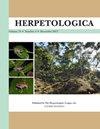Abiotic Factors Influence Thermal Conditions Determining Site Occupancy of Plestiodon fasciatus at High-Latitude Range Limits
IF 1.1
3区 生物学
Q2 ZOOLOGY
引用次数: 0
Abstract
Abstract: Climate change has historically resulted in the expansion, contraction, and shift of species ranges. High-latitude range limits in areas where no physical barrier prevents dispersal are of particular interest in light of species range contraction or expansion because they represent limits that may inhibit occupancy. MacArthur proposed that abiotic factors have a greater influence on species distribution approaching high-latitude range limits. We examined aspects of environmental structure that influence distribution of Common Five-lined Skinks (Plestiodon fasciatus) and are expressed in that species' population dynamics. Eight sites in the southern Shield region of Ontario, Canada were surveyed during the active season for P. fasciatus. We collected data on the canopy cover, slope angle, slope aspect, substrate, cover type, and temperature at sites where P. fasciatus was observed (microsites) and compared these data to the general site conditions (macrosite). We assessed population size using capture–mark–recapture methods and compared population age structure at eight sites to detect if there was a correlation between the characteristics of the macrosites, population size, and age structure. Abiotic factors were the primary limiting factors affecting distribution at high-latitude range limits of the species. Spatial ecology at the individual scale was influenced by sites with suitable thermal conditions. Our results confirm the importance of microsites with suitable thermal profiles as key habitat for ectothermic vertebrates at high latitudes. The influence of temperature as a limiting abiotic factor is expressed in population density of P. fasciatus. Conservation and restoration of high-latitude populations of ectothermic vertebrates should focus on ensuring thermal requirements of the species are met before other factors are addressed, as temperature is likely the single most significant limiting factor at high-latitude range limits.非生物因素影响热条件决定高纬度范围内筋膜胸齿鲨的地盘占用
摘要:从历史上看,气候变化导致了物种范围的扩张、收缩和转移。鉴于物种范围的收缩或扩张,没有物理屏障阻止扩散的地区的高纬度范围限制尤其令人感兴趣,因为它们代表了可能抑制占用的限制。麦克阿瑟提出,非生物因素对接近高纬度范围的物种分布有更大的影响。我们研究了环境结构的各个方面,这些方面影响了常见的五线皮鼬(Plestiodon fasciatus)的分布,并在该物种的种群动态中表现出来。对加拿大安大略省南部地盾地区的八个地点进行了调查。我们收集了观测到斑节藻的地点(微型地点)的冠层覆盖、坡度角、坡向、基质、覆盖类型和温度的数据,并将这些数据与一般地点条件(宏观地点)进行了比较。我们使用捕获-标记-再捕获方法评估了种群规模,并比较了八个位点的种群年龄结构,以检测巨大位点的特征、种群规模和年龄结构之间是否存在相关性。非生物因素是影响该物种在高纬度范围分布的主要限制因素。个体尺度上的空间生态学受到具有合适热条件的地点的影响。我们的研究结果证实了具有合适热剖面的微型站点作为高纬度外热脊椎动物的关键栖息地的重要性。温度作为一个限制性非生物因素的影响表现在筋膜藻的种群密度上。保护和恢复高纬度外热脊椎动物种群应重点确保在解决其他因素之前满足该物种的热需求,因为温度可能是高纬度范围内最重要的限制因素。
本文章由计算机程序翻译,如有差异,请以英文原文为准。
求助全文
约1分钟内获得全文
求助全文
来源期刊

Herpetologica
生物-动物学
CiteScore
4.60
自引率
0.00%
发文量
27
审稿时长
>12 weeks
期刊介绍:
Established in 1936, Herpetologica is a quarterly peer-reviewed journal serving herpetologists, biologists, ecologists, conservationists, researchers and the scientific community. The journal contains original research papers and essays about the biology of reptiles and amphibians, and covers many relevant topics including: behavior, conservation, ecology, genetics, morphology, physiology and taxonomy.
 求助内容:
求助内容: 应助结果提醒方式:
应助结果提醒方式:


